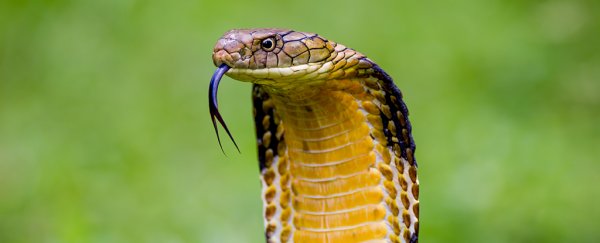The number of people getting bitten by exotic snakes in the UK is on the rise, and experts say it's because an increasing number of non-native snakes are being kept captive in homes as pets.
A new study logs 321 exotic snake bites on 300 different individuals between 2009 and 2020, involving 68 different species – about 30 a year on average. Compare that with 133 between 2004 and 2010, an average of 22.
The data was collected through records of snake bite enquiries to the National Poisons Information Service (NPIS) in the UK. Enquiries about bites from the European adder – the only poisonous snake native to the UK – or cases where the identity of the snake was unknown weren't included in the figures used for this study.
"Most of these bites occur to fingers, hands and wrists following deliberate handling interaction by people who keep snakes as part of their occupation or hobby," says David Warrell, a professor of tropical medicine at the University of Oxford in the UK.
"While ownership of many poisonous species requires a special licence in the UK, it is recognized that some individuals may keep these snakes illegally – meaning the true numbers of exotic snake bite injuries may be underestimated."
The 300 people affected included 72 children (aged 17 years or under). Of those children, 13 were 5 years old or younger, but none had severe injuries. Most of the bites – 207 or almost two-thirds – happened to men.
Out of all the people bitten, 15 had severe injuries. Those 15 include a single fatality, the tragic case of a reptile conservationist who died after being bitten by a king cobra, and having previously survived a bite from an eastern green mamba snake.
It's estimated that around 1 in 100 households in the UK now own a pet snake, and the report is an indication of the dangers that come along with keeping such an animal captive – even if these bites remain a rare occurrence overall.
"The prospect of being bitten by an exotic, non-native snake in the UK is still remote, with bites typically occurring in those keeping such snakes as part of their occupation or hobby," says Pardeep Jagpal, from the NPIS in Birmingham in the UK.
According to the report, nine people were bitten twice and one person had the misfortune to be bitten three times. As per the World Health Organization (WHO), there are more than 250 species of venomous snakes considered "medically important" in terms of the damage they can do with their bites.
Breaking the bites down by species, 184 came from the Colubridae family of snakes (including hognose snakes, king snakes and false water cobras), 30 came from the Viperidae family (including the western diamondback rattlesnake and the copperhead), and 14 came from the Elapidae family (most commonly Indian cobras, monocled cobras and king cobras).
The NPIS provides expert advice and medical care in the UK to those who have suffered a snake bite, but the researchers say that those who choose to keep these animals as pets must accept the risk of being bitten as "one of the hazards of ownership".
"Rapid access to expert clinical advice and the availability of appropriate anti-venom are important considerations when these accidents occur," says Jagpal.
The research has been published in Clinical Toxicology.
